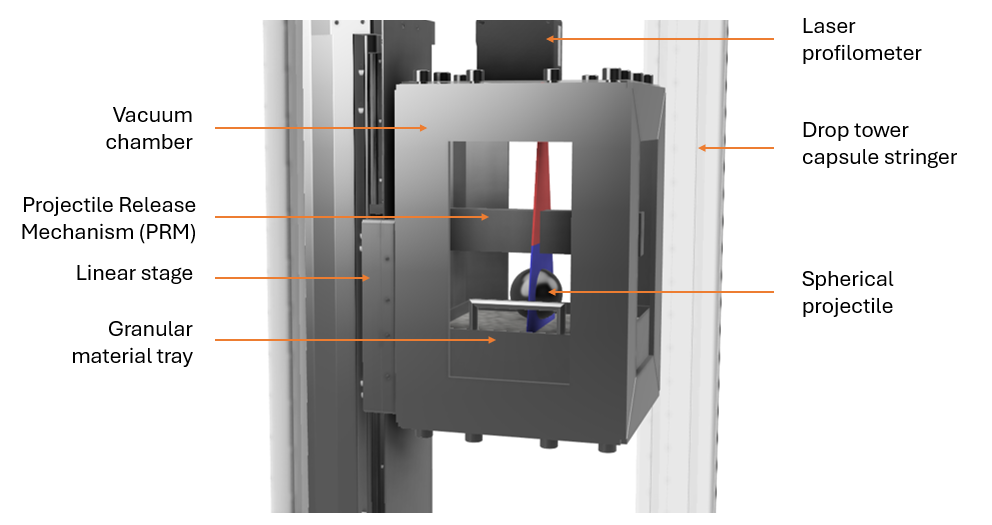- 1Institut Supérieur de l'Aéronautique et de l'Espace (ISAE-SUPAERO), Université de Toulouse, Toulouse, France (alexia.duchene@isae-supaero.fr)
- 2University of Duisburg-Essen, Faculty of Physics, Lotharstr, Duisburg, Germany
Various bodies in the solar system such as the Moon, Mars and asteroids are recovered with fine and powdery regolith. The behavior of such materials remains poorly understood due to their granular nature in a low gravity environment. Being able to retrieve the mechanical properties of the surface helps to better predict the regolith behavior during space missions involving sampling, landing, or roving components interacting with the surface. One of the parameters of interest is the bearing capacity, which is the maximum force a surface can withstand before experiencing rupture (shear failure). In low-gravity conditions, cohesionless material is expected to be more readily fluidized and have lower strength [1; 2; 3; 4; 5]. Sinkage of an object is independent of the gravity for cohesionless material in a quasi-static regime [3; 6]. However, the expected behavior of cohesive materials is still poorly understood and under debate [7; 8; 9]. In a reduced gravity environment, the importance of cohesive forces is expected to increase (e.g. [10]).
To develop a better understanding of the role of cohesion in surface dynamics and estimate the bearing capacity, the sinkage experiment campaign named SILOE (Surface Investigation in Low gravity Environment) will be conducted in December 2024 in the GraviTower Bremen Pro at ZARM drop towers facility (Bremen, Germany) with the support of the ESA Academy Experiments programme – Drop Towers.

Figure 1: Preliminary design of the experimental set-up. The beam of the laser profilometer is represented with the red and blue area, with the blue zone being the visible and measurable zone.
The sinkage experiments will be conducted under vacuum at 10 Pa, which is sufficient to remove the interstitial air pockets and water molecules inside the granular medium [11]. The chamber is a box made of acrylic glass panels of the following dimensions: 0.2 x 0.2 x 0.3 m (l x w x h) (Fig. 1). Every trial will involve releasing a spherical projectile of 5 cm using an electromagnet mechanism. The release height above the surface will be very small and the projectile will collide with the surface with a very small velocity (< 0.4 m/s). The vertical displacement of the projectile will be measured using a laser profilometer and two high-speed cameras, placed on the top and side of the chamber.
The experiments will be performed at three different levels of gravity: Earth gravity, and at two reduced gravitational accelerations (10-1 and 100 m/s²) achieved by combining the GraviTower and a motorized linear stage. Five different granular materials with five different levels of cohesion (from ~ 0 to > 1000 N/m²) will be selected to focus on the role of cohesion depending on the gravitational acceleration. Other mechanical properties, such as the internal angle of friction, density, and grain size, will be selected to remain as constant as possible across the different materials.
The SILOE experiment objective is to determine and quantify the effect of cohesion on the bearing capacity for reduced gravity levels. The results are directly applicable for data interpretation of the upcoming JAXA MMX mission (in particular the IDEFIX rover [12]) and the ESA Hera mission [13; 14].
Acknowledgements:
This project is carried out with the support of the Education Office of the European Space Agency, under the educational Experiments Programme. This project also received funding from EUR TESS N°ANR-18-EURE-0018 in the framework of the Programme des Investissements d’Avenir, and the Bourse Espace 2024 scholarship by the Fondation Ailes de France. AD acknowledges PhD funding from University of Toulouse III, and CR acknowledges PhD funding from CNES and ISAE-SUPAERO. This project benefitted from funding from CNES, and from the French ANR Tremplin-ERC ‘GRAVITE’.
References:
[1] Murdoch et al. (2017), MNRAS. [2] Murdoch et al. (2021), MNRAS. [3] Sunday et al. (2022), A&A. [4] Walsh et al. (2022), Sci. Adv. [5] Arakawa et al. (2021), Science. [6] Kobayashi et al. (2010), J. Terramech. [7] Nagaashi et al. (2021), Icarus. [8] Nagaashi et al. (2023) Sci. Adv. [9] Schäfer et al. (2017), P&SS. [10] Scheeres et al. (2010), Icarus. [11] Brisset et al. (2018), Prog. Earth Planet. Sci. [12] Michel et al. (2022), Earth Planets Space. [13] Michel et al. (2022), Planet. Sci. J. [14] Bigot, Lombardo et al. (2024) Nat. Commun.
How to cite: Stankiewicz, M., Dghais, S., Duchêne, A., Bigot, J., Robin, C., Kollmer, J., and Murdoch, N.: SILOE: Bearing capacity experiments in low gravity, Europlanet Science Congress 2024, Berlin, Germany, 8–13 Sep 2024, EPSC2024-1184, https://doi.org/10.5194/epsc2024-1184, 2024.